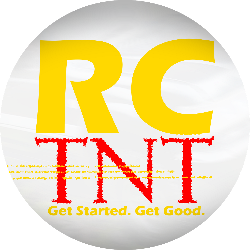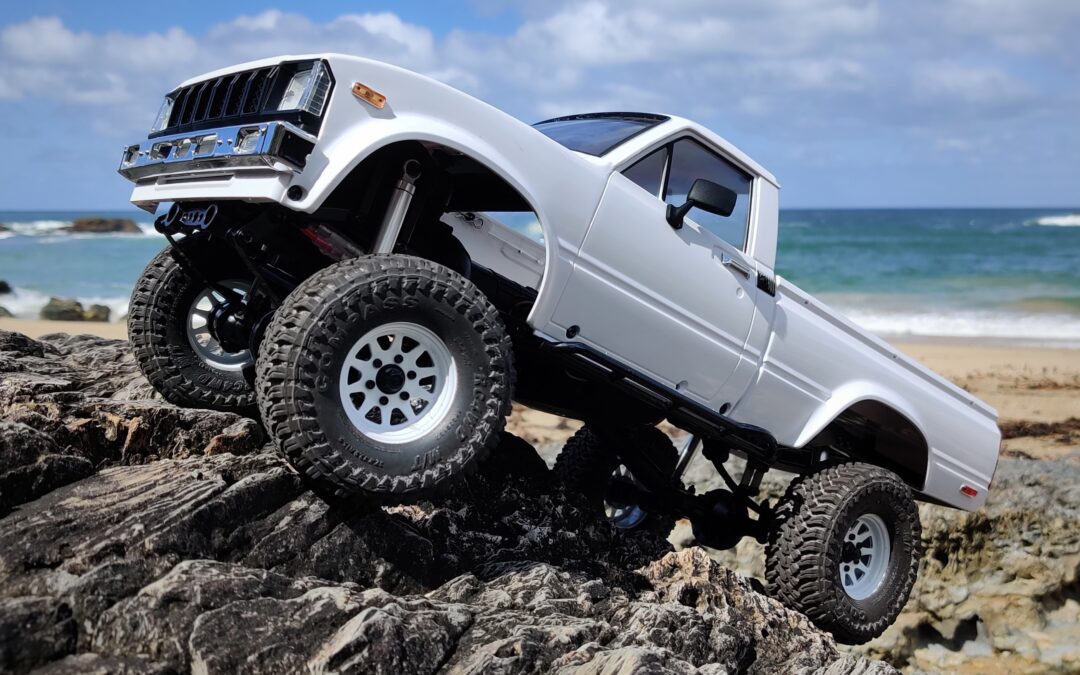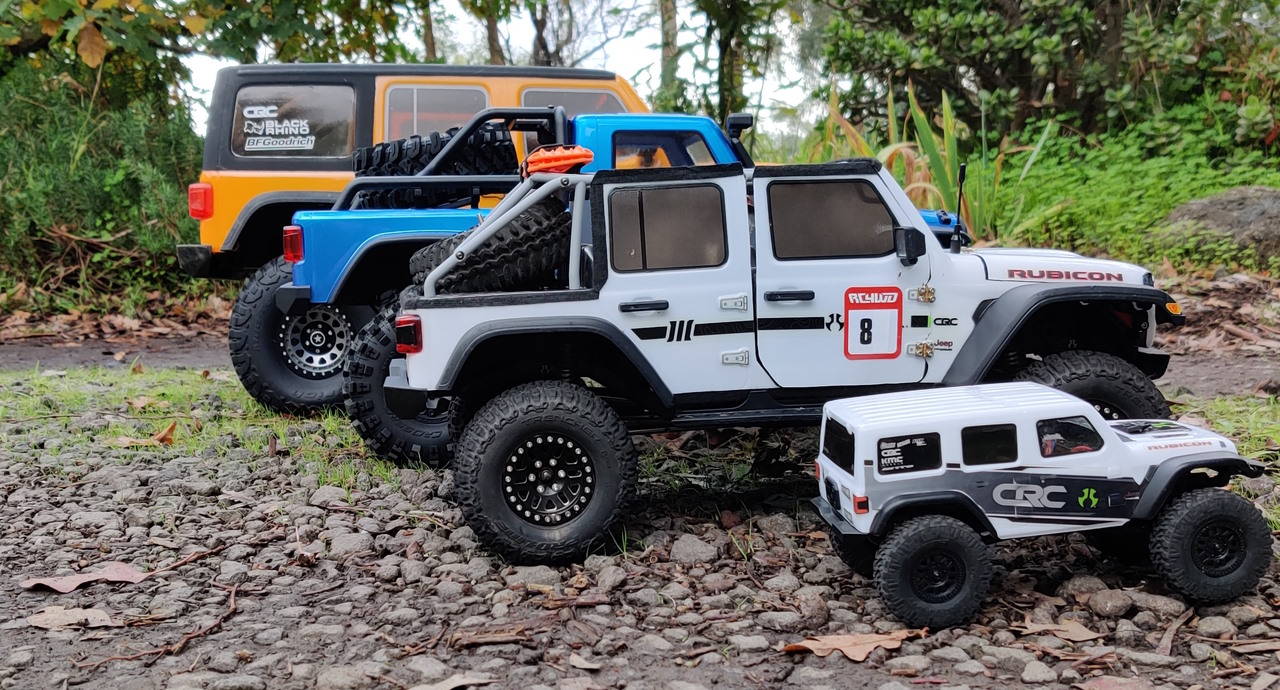RC4WD Goes Back to Its 80s Roots
RC4WD has released the Trail Finder 3, after enjoying a decade of leaf-sprung, scale dominance in the 1/10 RC hard-body crawler arena. The Trail Finder 3 is certainly different to its predecessor, the Trail Finder 2, but it isn’t necessarily what you’d call “new”. We’ll get to that below as we take a closer look at RC4WD’s latest hard-body scale crawler and trail truck.
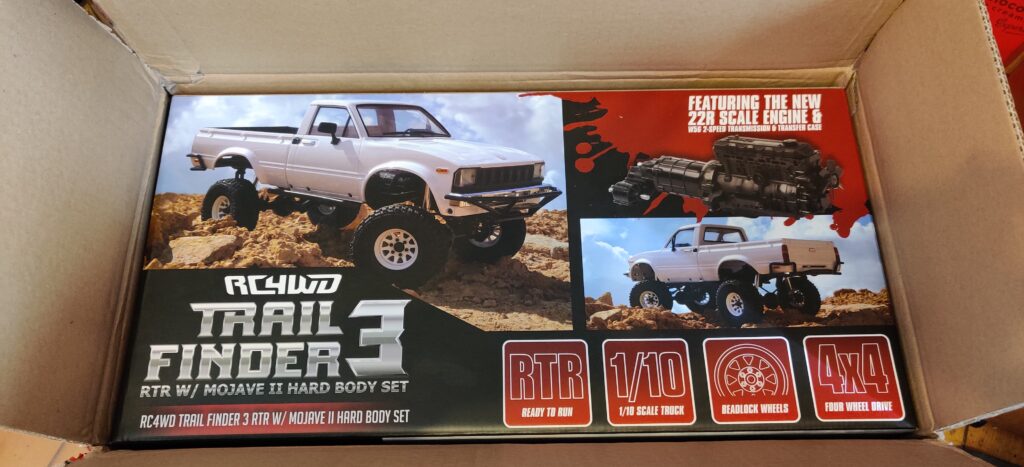
Out With The Old…
…and in with the, er, same? Well, yes: the Trail Finder 3 rocks the Mojave II Hard Body Set, same as on the Trail Finder 2 (see our TF2 video here). It’s finished in a new color – glossy white – and comes with a few choices of decals on the sticker sheet. The body is molded from ABS plastic and features a black flat bed and various scale trim pieces, such as side mirrors, wipers, chrome door handles and an intricate multi-piece front grille. There are light buckets front, side and rear, ready to be populated with an LED light kit if desired.
What’s actually new here is how the body sits higher on the Trail Finder 3 than on the Trail Finder 2, plus the glossy white finish and a windscreen sticker that says ‘RC4WD TRAIL FINDER 3’. And that’s about it. There are no wheel arches, so looking from the side you can still see into the chassis and through the other side. The body also suffers from the same clumsy 4-screw plus two body pin mount points as employed on the Trail Finder 2. So far, we could be looking at a minor model update for the Trail Finder 2. Perhaps we’ll find something new and improved underneath the familiar Mojave II body!
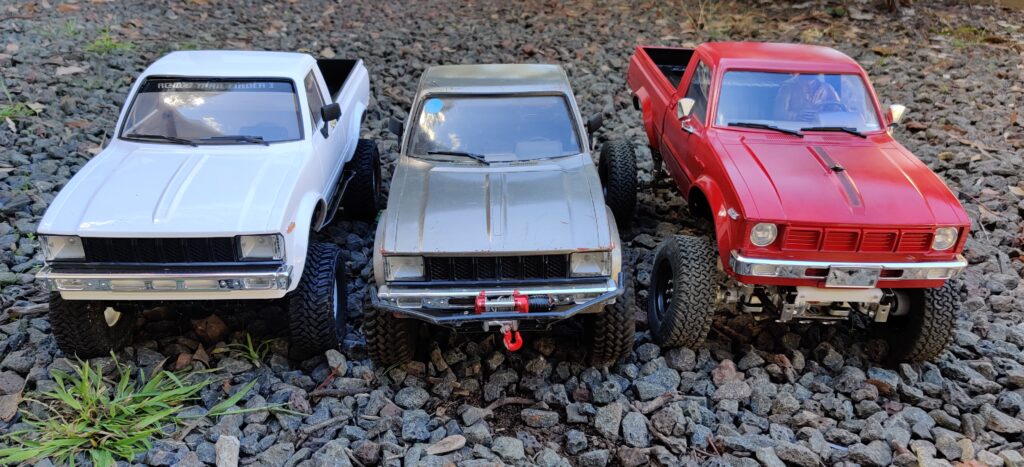
Department of the Interior
There is a dash and steering wheel in the body, but that’s about it. With the missing wheel arches, the body seems a little empty. Wheel arches would help to make the vehicle feel more ‘solid’, but even so, you can still see wiring and components when looking down through the windows and windscreen.
Thankfully, Tamiya makes a lightweight interior that includes a new dash and bench seat. For a few more dollars, there’s also a plastic driver model available that bolts right in. It installs without issue in the Mojave II body as the dimensions are identical to the Bruiser and Mountain Rider bodies for which it was originally designed. A coat of paint, 5 screws and you have an interior that helps complete the scale look of the Trail Finder 3 – without really harming its rock performance. That’s a win!
(The part number for the interior is TAMIYA 19000315 and the driver is TAMIYA 54416).
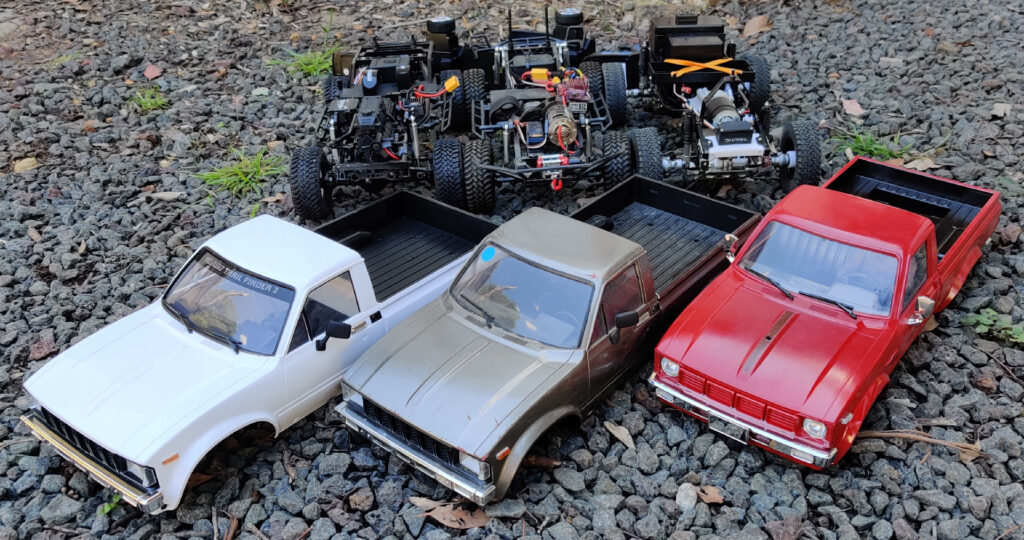
Trail Finder 3 Updates
Immediately obvious are a few changes over the Trail Finder 2:
- Steel C-chassis rails instead of CNC-cut aluminum rails;
- Wider rails in the rear, tapering to a more narrow front, instead of the Trail Finder 2’s parallel rails. This is also now more like the Toyota Hilux on which the TF3 is modelled as well as going back to its roots, being the same tapered rail profile as on the Tamiya Bruiser;
- An updated layout for servos and battery plate;
- Stonking great 22R faux engine that looks fit for a truck rather than a small car;
- Mid-mounted steering servo with bell crank, taking a step back four decades to the Bruiser’s design from the 80s (but it’s somehow worse than that!); and,
- Plastic cross-braces on the chassis rather than the cut alu struts of the TF2.
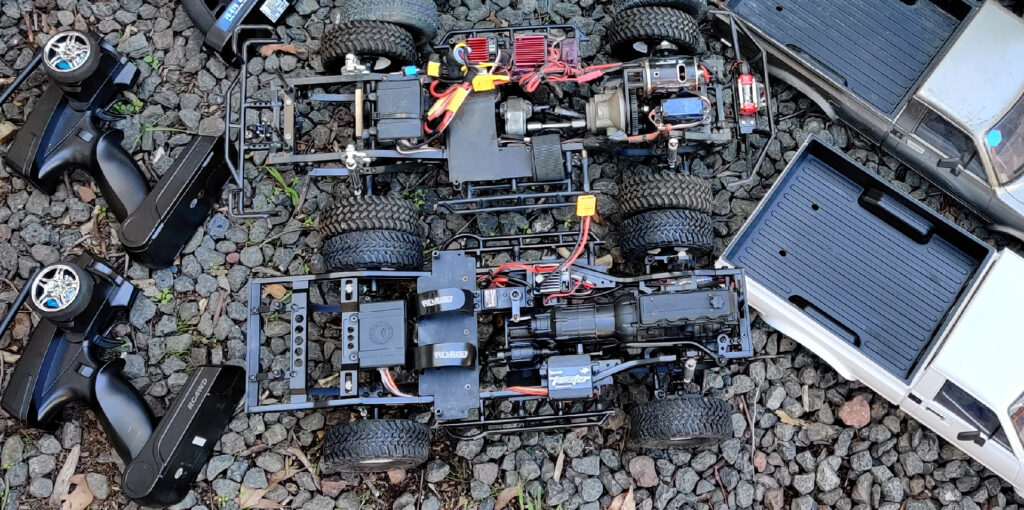
Geared Up
The Trail Finder 3 RTR w/Mojave II Hard Body Set comes equipped with a 2-speed transmission and integrated transfer case in the one unit. This is a change from the Trail Finder 2, which included a 2-speed transmission and separate transfer case in the kit and a single-speed transmission and the same separate transfer case in the RTR model. You can install an 11, 12 or 13-tooth pinion on the motor in the TF3, but that’s it for tuning by gearing.
The spur gear cannot be changed for a different size, as it’s custom-made for this transmission and features a second, integrated gear. Your only options to change vehicle gearing is to swap the pinion or to a different motor entirely. Even so, this is probably enough – the two-speed transmission gives a useful gap between slow crawl and fast trail drive, even on 2S power. It’s Good Enough for this vehicle’s likely intended purpose. If you need more variation in speed and control, some of the modern brushless systems are well up to the task, in the most extreme case. Stock equipment will be fine for most drivers.
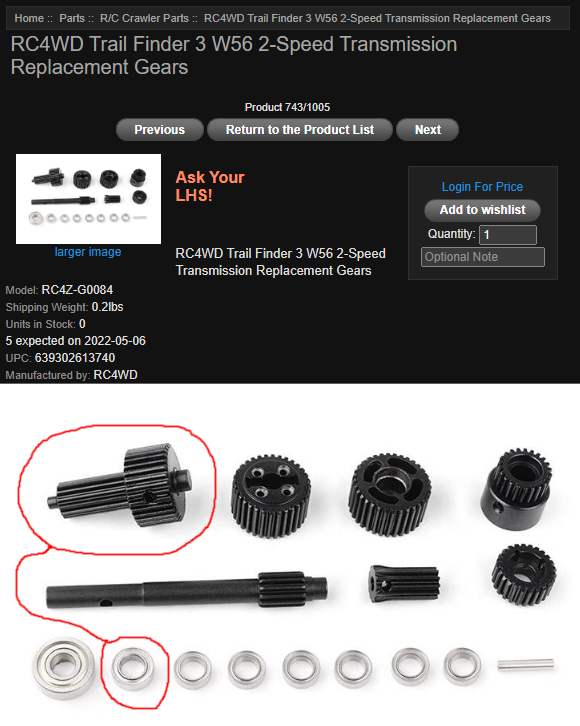
Suspension of Disbelief
The Trail Finder 3 ships with leaf suspension front and rear. This is great for realism. There are 3 leaves in the stack and they’re attached to the Yota II axles with U-bolts. (On the Trail Finder 2 with identical axles, the leaves were attached directly through tapped holes on the axles. Those axle holes are present but unused on the TF3). For reference, the Tamiya vehicles had two rather than three leaves in their leaf stacks, whilst the Trail Finder platform has employed 3 leaves on both the TF2 and TF3.
The leaves look great but there are two problems. Both can be addressed, one more easily than the other:
- The leaves are too stiff for the weight of the body. This impedes articulation. The easiest remedy here is to remove the middle or smallest leaf on each corner. Removing the smallest leaf will give a softer ride through the entire articulation cycle (ie. it’ll be softer from slight to maximum articulation), whilst removing the middle leaf will give softer travel at first, increasing to stiffer articulation at a higher point. Experiment to find what you like best – or even remove both the small and middle leaves if you like. Try, test, adjust as needed.
- The bigger issue is one that affects both scale and steering: the front leaf suspension has the shackles at the front and the static mount at the rear. The Trail Finder 2 did this too, in stock configuration. Functionally, the leaves can still cycle but it means there’s a lot of slop in the steering. Not ideal. To fix this, you’ll want to move the solid mount to the front and the shackles to the rear of the leaves. Some cutting may be required – but make this one of the first things you do and you’ll find improvement.
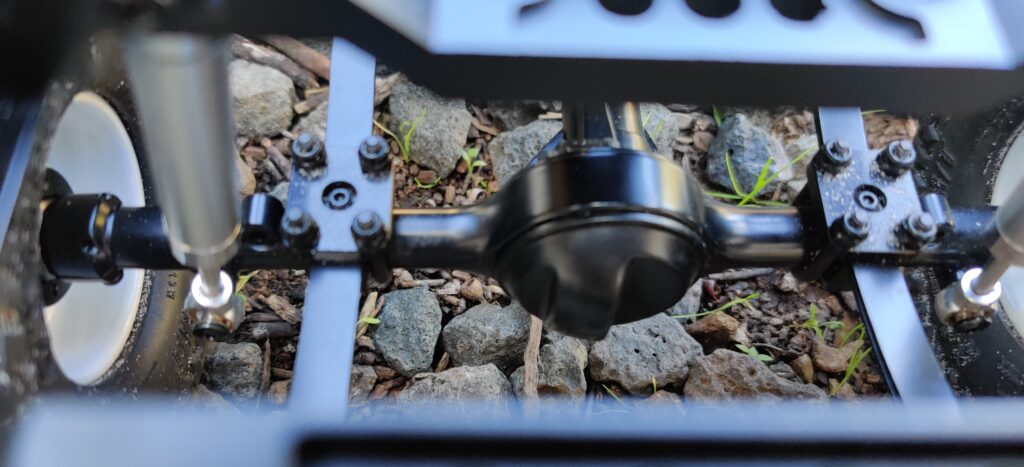
Steering Me Wrong
If there’s one overarching design oversight with the Trail Finder 3, it’s this: sloppy steering. Seriously sloppy steering! The mid-mounted steering servo moves a bell crank that moves the steering link, which moves the behind-the-axle (BTA) steering. The original Tamiya Bruiser, Mountain Rider and Mountaineer worked the same way, though with a one-piece bell crank. Meanwhile, the TF3 bell crank is a three-piece design (just the bell crank!) and there is a LOT of movement in the lower arm on the bell crank. In stock form, there’s way too much movement in the front wheels. This needs to be addressed. We’ve tried tightening it further, but that results in binding.
There are a few ways to go about this. We could remove the mid-mounted steering entirely and fabricate a bracket for the steering servo to mount up-front like a more traditional CMS (Chassis-Mounted Steering) design. However, that may detract from the pretty look of the chassis and may introduce other problems with geometry. The better solution may be to try to improve the bell crank assembly, removing the slop in the lower piece on the crank pivot shaft. We’ll keep you posted on this – we’ll do a video for the TF3 with some fixes in the coming weeks.
The car drives okay in stock form. There is a lot of slop in the steering because of the bell crank issue and the weird backwards-mounted leaf design, as above. But these aren’t enough to ruin the truck. We’ve had it on all manner of terrain over March 2022 in preparation for our review video (linked near the end of this article) and for this article itself. The truck is fun to drive in stock form. Flawed, yes. But fun nonetheless!
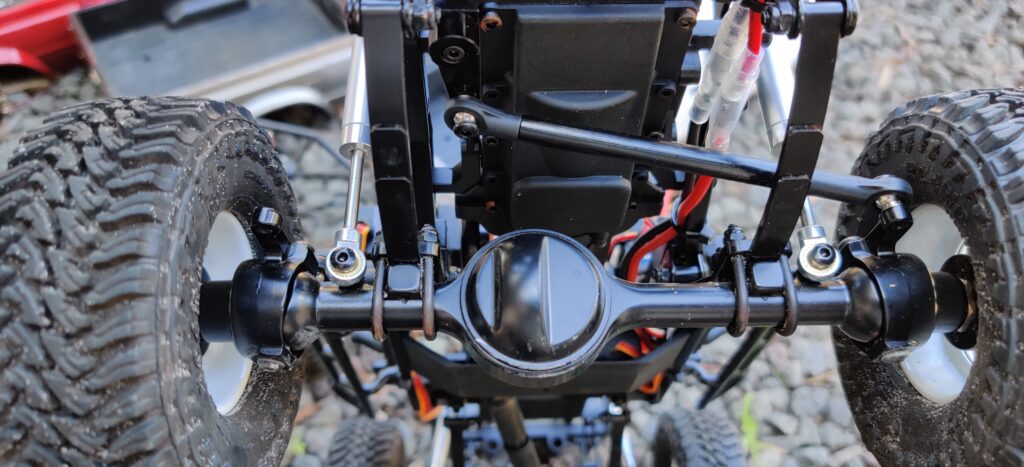
Wheels & Tires
Wheels are the standard RC4WD OEM 6-Lug Stamped Steel 1.55″ Beadlock Wheels. They look great. They work well. No complaints here, they really suit the body.
The RC4WD Compass M/T 1.55″ Scale Tires are a nicer design than those that came with the Trail Finder 2. There’s more detail in the rubber and the lugs are all grooved for increased flexibility. The rubber compound is sticky enough and the included foams soft enough that the truck grips rocks well, despite the lack of articulation from the too-firm leaf suspension and the steering slop from the awful bell crank design. They are a big part of why the truck is still fun to drive, despite those two design issues.
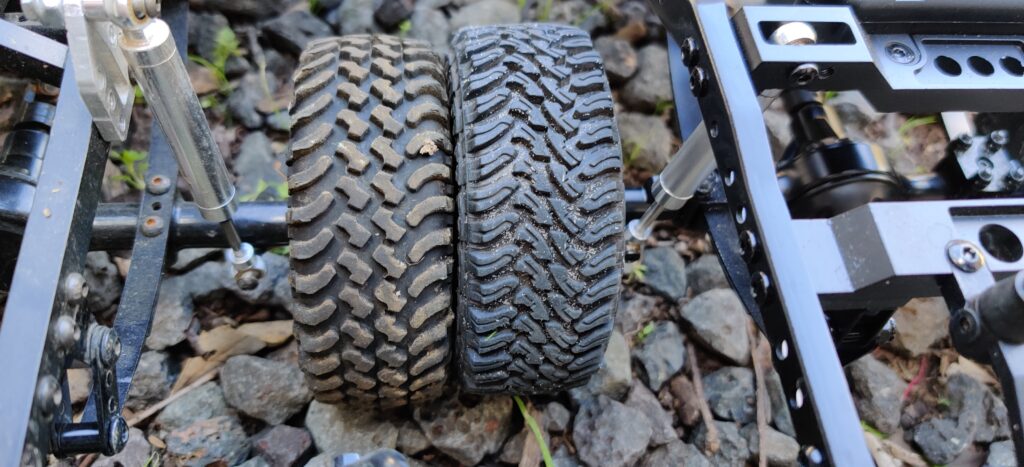
Shafts & Skid
The plastic drive shafts RC4WD issued with the Trail Finder 2 for years were known to be weak. They’d break under the torque of even moderate rock crawling, let alone withstanding much in the way of abuse.
The new shafts on the Trail Finder 3 are one area where there’s improvement over the TF2. Though they’re still plastic, their design has more support material in places where it matters. They will still break with tougher crawling, we expect, but you should expect better performance from them before that time. However, anyone who drives their TF3 regularly will find themselves with steel drive shafts eventually. Keep this in mind when budgeting for the truck purchase.
Another area that sees improvement over the TF2 design is the skid plate. It’s no longer the low-hanging aluminium bulge as found on the Trail Finder 2. Instead, there’s now a nice, flat plastic skid under the Trail Finder 3 that is more broad and higher up into the chassis. The vehicle should slide over obstacles that saw the TF2 get stuck, so this is a welcome update.
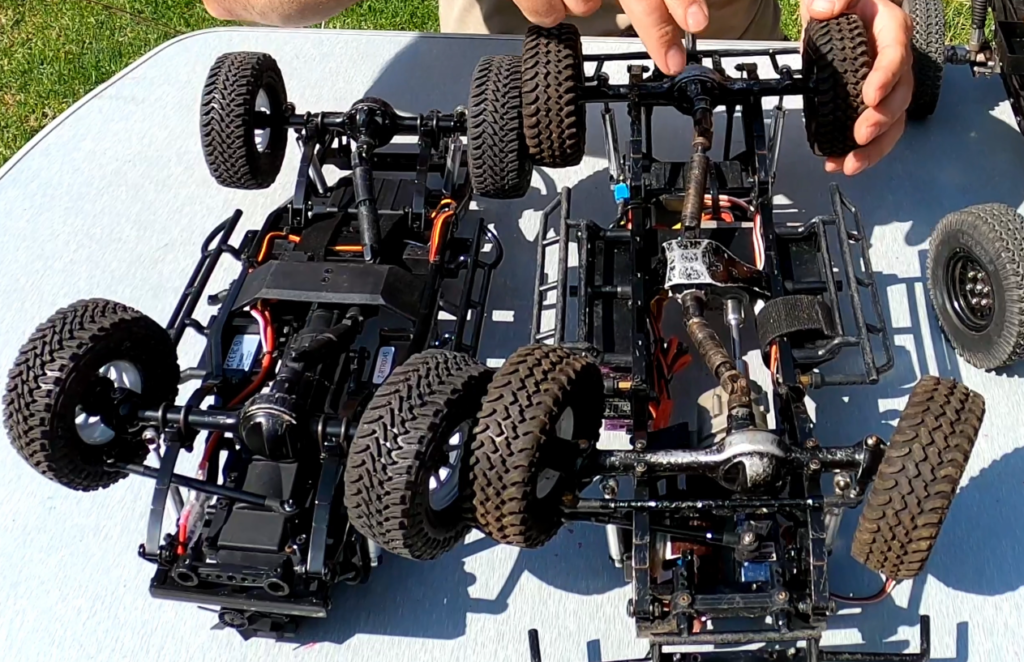
Scale Engine is Weird
This one gets its own section. The 22R motor that sits under the hood is oversized. It looks suited for tractor or a bigger truck. In real life, there’s no way an engine this big would be found in a pickup. The engine takes up a lot of space, necessitating the mid-mounted location for the steering servo. There is a lot of empty plastic inside the 22R model and yet, the bearings within are tiny, save for one. If running wet, it seems these bearings may be the first point of possible failure. It’s a confounding design, honestly. Still, we’ll see how durable it ends up being. It’s running well so far.
So, the hood doesn’t open. The steering needs fixing. The bearings are concerningly small and the scale 22R engine is ridiculously huge. This adds up to considering removing the 22R entirely from the vehicle and putting in our own custom two-speed transmission. Then, we’d be able to fit the steering servo up-front with the gained room. We’ll have a play with this and get back to you. For now, it stays and it works well enough we can overlook it, monstrously large as it is!
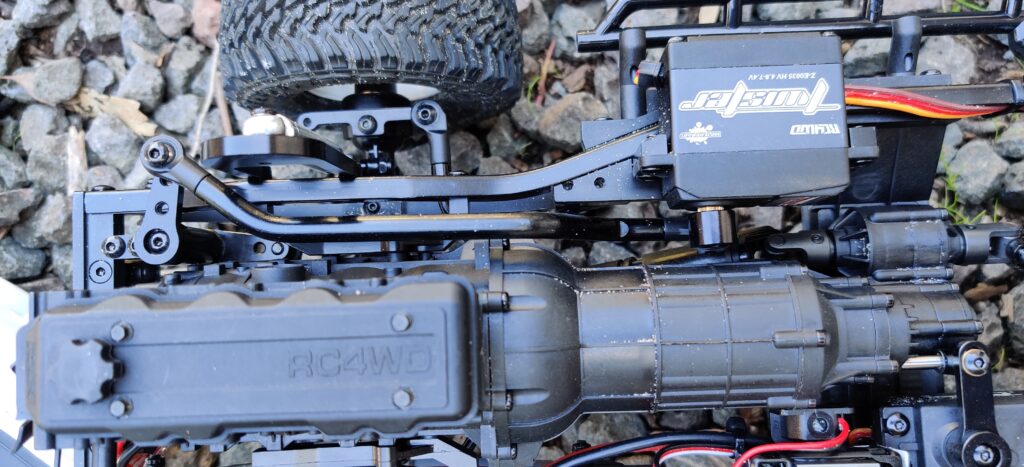
Bit of a Stretch
The included XR3 3-channel 2.4GHz radio system hasn’t changed with this new release, besides minor cosmetic updates. Channel 3 end points are easier to set on the updated version, getting their own dedicated dials. It takes 4x AA batteries and is as power-efficient as any other modern radio. From a comfort perspective, it is lightweight and easy enough to use.
However, as with the included radio on the TF2, you really need two hands to operate it. The steering wheel is just too far away for any but the largest hands to reach with outstretched thumb. This may not be a problem for many, but for those of us who like to drive with one hand on the trails, it’s an inconvenience serious enough to warrant fitting fatter foam on the wheel, a 3D-printed thumb extension or outright replacement to a more comfy transmitter.
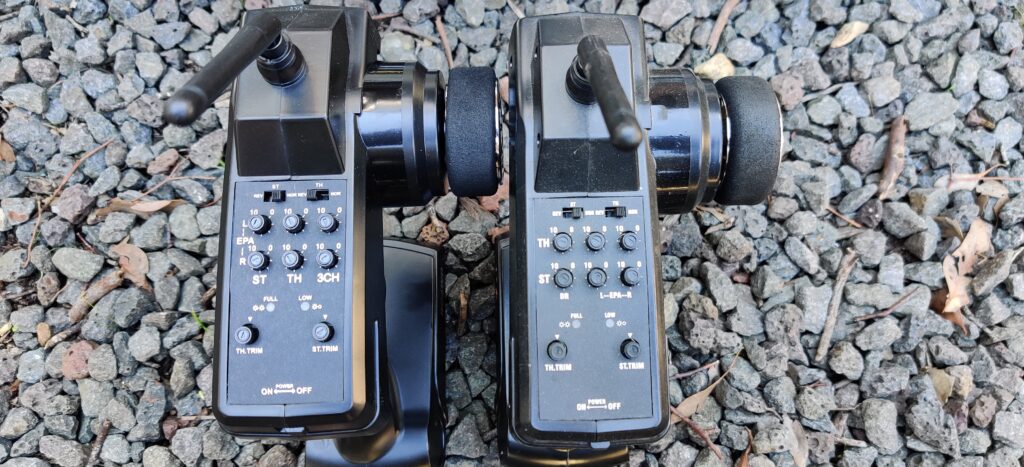
Trail Finder 3 Batteries
RC4WD provides branded AA alkaline batteries for the transmitter – handy! They also provide a universal NiMH charger and 3000mAh NiMH battery in the RTR package. This gives ample runtime and charges in about 5 hours from empty. It fits neatly on the plastic battery tray on the chassis and is perfectly suited to this vehicle. The ESC has a jumper you should change if you swap to using LiPO batteries. This will ensure the low voltage cut-off is activated to protect your LiPO batteries. (NiMH can be run flat without problem).
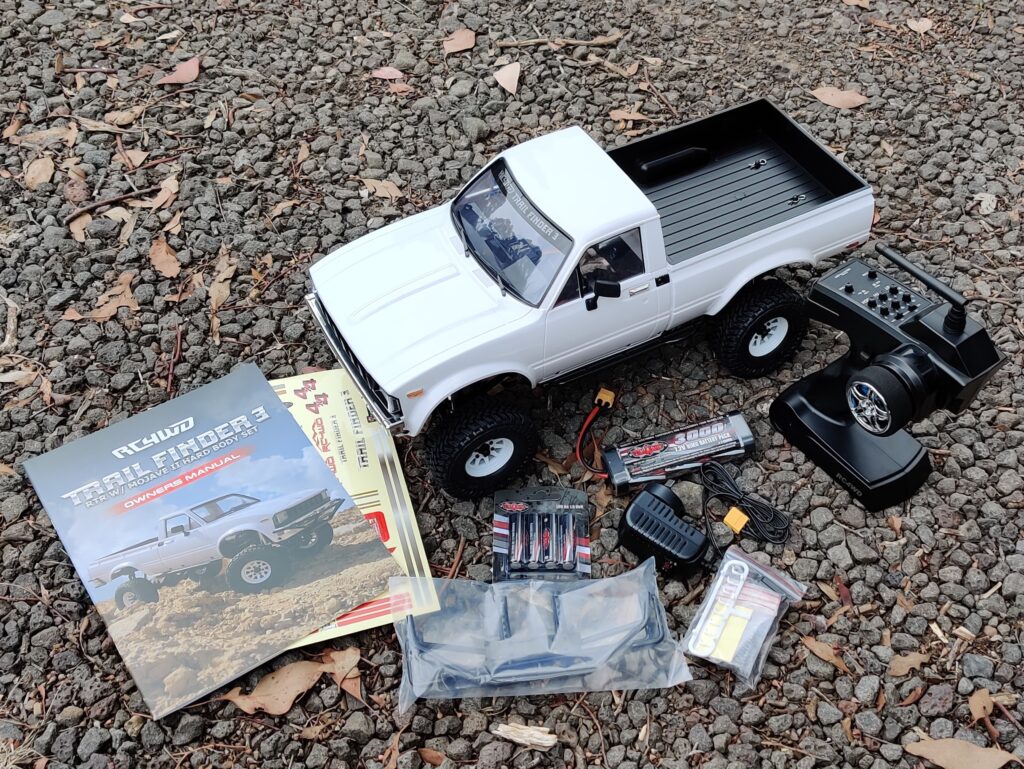
Manual & Stickers
RC4WD gets the manual pretty much right. It’s issued in multiple languages, wrapped in an attractive cover. There’s a sticker sheet included with two different designs to put onto the truck. The manual includes a page with a guide for where to apply these stickers, which is welcome and most helpful. There isn’t much in the way of troubleshooting for this RTR machine, but the internet and RC4WD after sales service is something we’ve used from Australia in the past – and they’ve been responsive and speedy in their resolutions. No problems here.
If we could add one thing to the manual, it would be exploded parts diagrams of all the gear in the vehicle. The TF2 shipped as a kit and RTR option for years. Getting the ‘kit’ manual on both variants can be helpful with servicing and parts replacement and it’s something that would have been appreciated on the Trail Finder 3 RTR.
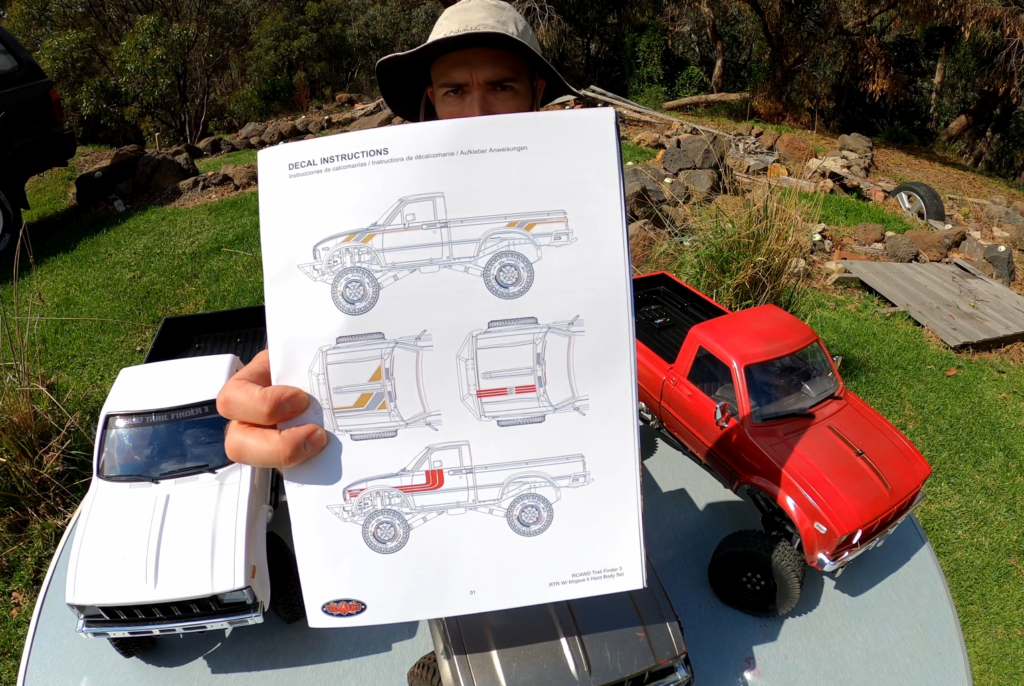
The Verdict
We’ve travelled 3,000 miles with this thing over March. Driven it on the beach, rocky headlands, sandy trails, dirt trails and on our rocky comp test course. We’re looking forward to working on it and improving it, which will add to the eventual satisfaction of making our TF3 look and go the way we want.
Issues notwithstanding, the smiles per mile are such that we can still recommend it. The Trail Finder 2 was (and remains) an excellent scale choice, but the Trail Finder 3 adds a solid next page to the nearly 40-year heritage of the Tamiya Bruiser that started it all back in 1985.
It is not without its design issues but on the other hand, nothing here is bad enough to overshadow the strongest thing the Trail Finder 3 gets right: fun. It’s fun to drive! It looks great and it goes well. And for this hobby, that’s pretty much the whole point, isn’t it?
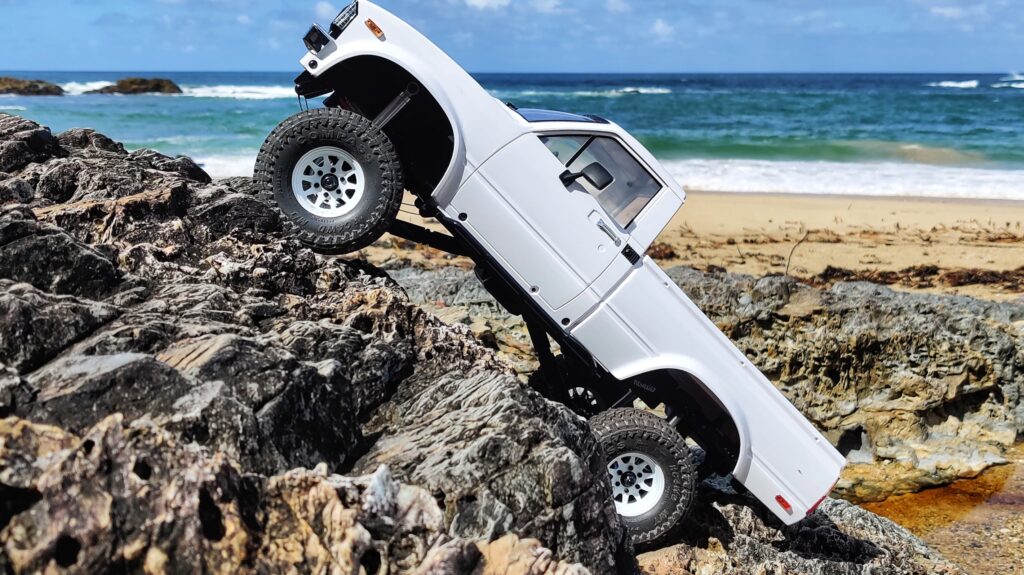

Craig Veness
RC-TNT
Craig has been into radio control since the 90s and into RC crawling since about 2010, when a Losi MRC started the obsession! Now it’s all rocks this and crawl that and upgrade all the things! …You know how it is, right? Welcome home 🙂
